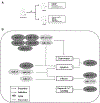Aging, MicroRNAs, and Heart Failure
- PMID: 30704792
- PMCID: PMC10544917
- DOI: 10.1016/j.cpcardiol.2018.12.003
Aging, MicroRNAs, and Heart Failure
Abstract
Aging is a major risk factor for heart failure, one of the leading causes of death in Western society. The mechanisms that underlie the different forms of heart failure have been elucidated only in part and the role of noncoding RNAs is still poorly characterized. Specifically, microRNAs (miRNAs), a class of small noncoding RNAs that can modulate gene expression at the posttranscriptional level in all cells, including myocardial and vascular cells, have been shown to play a role in heart failure with reduced ejection fraction. In contrast, miRNAs role in heart failure with preserved ejection fraction, the predominant form of heart failure in the elderly, is still unknown. In this review, we will focus on age-dependent miRNAs in heart failure and on some other conditions that are prevalent in the elderly and are frequently associated with heart failure with preserved ejection fraction.
Published by Elsevier Inc.
Figures

References
-
- Moskalev AA, Shaposhnikov MV, Plyusnina EN, et al. The role of DNA damage and repair in aging through the prism of Koch-like criteria. Ageing Res Rev 2013;12:661–84. - PubMed
-
- Blackburn EH, Greider CW, Szostak JW. Telomeres and telomerase: the path from maize, Tetrahymena and yeast to human cancer and aging. Nat Med 2006;12:1133–8. - PubMed
Publication types
MeSH terms
Substances
Grants and funding
LinkOut - more resources
Full Text Sources
Medical

